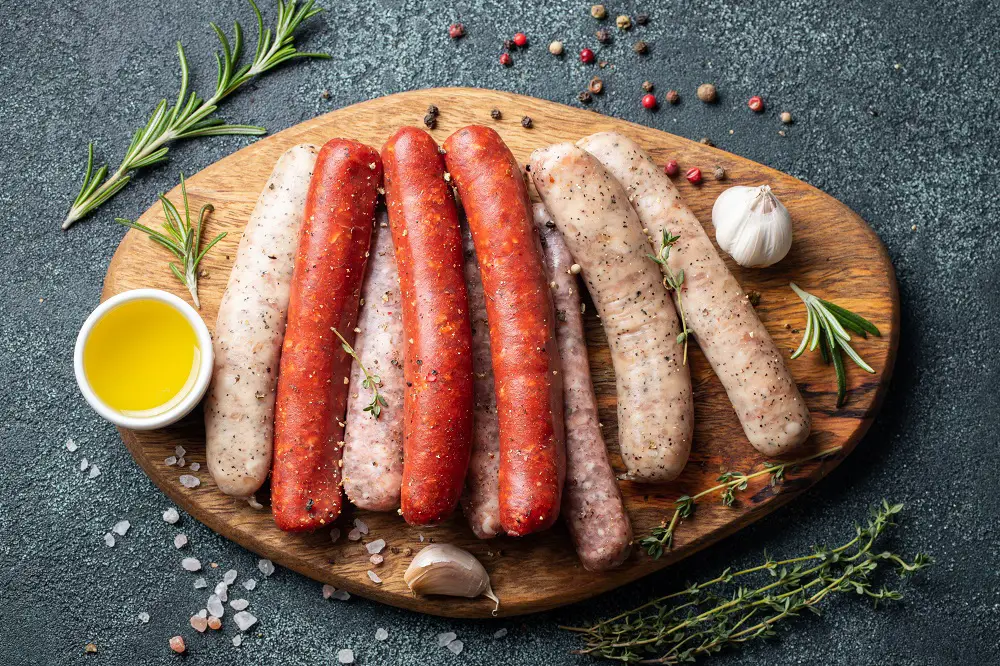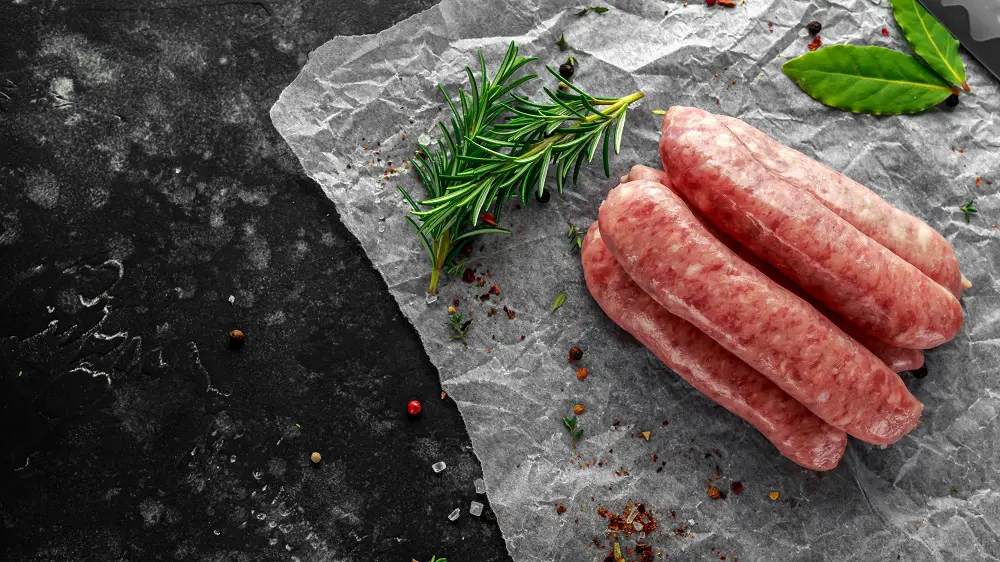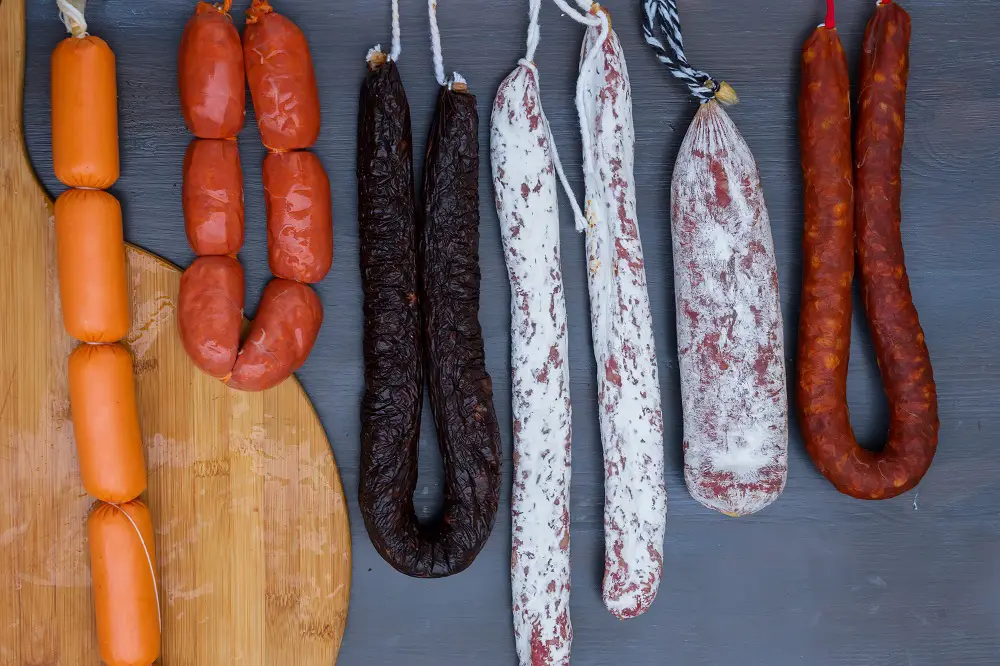
When the time comes to stuff your sausages, one of the most important aspects of the process will be choosing the right casing. While in the majority of cases, the type of casing is dictated by tradition, different casings are still needed for various processing methods, the ingredients you put in the sausages, and most importantly – the actual size and type of the sausage.
In this beginner’s guide to sausage casings, we will go over all of the casing types and discuss their pros, cons, and most common uses.
The majority of casings out there are either natural, fibrous (cellulose), or collagen, as well as synthetic options which are gaining a lot of momentum as of late. Within those variations, these casings are further divided based on their color, texture, sizes, and more.
Before we dive deeper into this topic, make sure you check out my guide on some of the best sausage stuffers in 2021! There, you will find awesome models that will help you make delicious and finely stuffed sausages at a bargain price. Now, let’s start with the most important question regarding this topic…
Table of Contents
What Are Sausage Casings?
The sausage casing, commonly referred to as the “skin” of the sausage, is the sock-like material that goes around your sausage. These casings are there to keep the sausage in a fixed shape allowing it to remain consistent and well-protected from the external elements, while simultaneously allowing a small amount of “breathing” to happen.
In other words, the sausage casing is what allows us to shape and produce sausages theoretically in any way, shape, or form we want to. Following centuries-old traditions, certain casings also bring a lot of traditional value along, making them the centerpiece of most family sausage recipes.
The casing is also one of the most distinguishing parts of various types of salamis or sausages out there. The casings nowadays can be easily divided into artificial and natural. The natural ones have set the tradition of enwrapping sausages in casings a very long time ago, and unlike synthetic (or artificial) ones, they have a very peculiar production methodology behind them. Let’s talk about that now!
How are they made?

The process of making sausage casings is very interesting and has origins tied to both European and Chinese culture. For them, people used casings from pigs, cattle, goats, and sheep. Using horse’s intestines wasn’t a rarity either, especially in villages that relied primarily on horses for their meat.
To prepare the intestine, people flushed it thoroughly with water and then did an additional clean-up with salt and water. The fat on the outside of the intestines is also removed, so is the internal mucosa (the inner-most layer).
Once the casings are clean, they are salted one more time to reduce the water in and around them. This prevents bacterial growth, or in other words – prevents the casings from spoiling. Once the casings are ready to be used, they are once again cleaned with fresh water to remove all the extra salt and have them ready to be stuffed with meat.
Types of Sausage Casings
As I already pointed out, sausage casings are divided into two large groups – Natural and Artificial. Further, into these two groups, there are quite a lot of other casing types. In order to cover the most amount of information for each type, we will create our own categories to go through:
- Natural casings
- Collagen Casings
- Fibrous (cellulose) casings
- Other artificial casings
Natural casings
In the USA, the most common natural casings used these days are – hog, beef, and sheep. Either one of those casings is quite rough in its exterior (and interior) mainly due to the fact that they have been roughly scraped when processed. Remember, this is the actual intestine of the livestock with its inner-most and outer-most layers scraped or removed. This is also one of the main differentiating traits between natural and artificial casings, as one will look far more coarse and irregular than the other.
The reason people use this middle layer of the intestine (called the sub-mucosa) is that it is naturally rich in substances such as collagen, giving it relative flexibility and lots of strength. These casings are relatively easy to stuff and can withstand processing in a smokehouse.
If you buy them from the market, natural casings will come in lots of salt or in saline solution, which is a liquid that doesn’t allow them to degrade or change over time. The ones that come covered in salt must be well flushed before used. Apart from that, all-natural casings must soak in lukewarm water for around 20 minutes before you get to the stuffing. If you have a few leftover casings, you can pack them with salt again and leave them in a freezer for more than a year.
Hog casings
Hog casings are, by far, the most common type of natural sausage casing. They are used in things like bratwursts, Italian sausages, kielbasa, bologna, and others, depending on their length.
Sheep casings
In general, the sheep intestine is narrower than the one of hogs. This is why it is used in making small-link sausages such as most breakfast sausages. These casings are also used in hot dogs and everyone’s favorite snack sticks.
Beef casings
Beef casings are further divided into beef rounds, beef middles, and beef bung caps. The rounds are very low on fat and are great for blood sausages, Holsteiner, Mettwurst, and other types of sausages! The beef middles are thicker and have some fat in their wall, making them good for dry sausages like bologna, salami, and others.
Lastly, the bung caps are made out of the large intestine of the cow, making them the largest type of casing on this list. They are good for wide sausages such as capicola, souse, bologna, and others! Another thing you have to consider with natural casings is their quality. If you buy them, in most cases, the casings will come with a grade (typically A or B).
Grade A natural casings will have no weaknesses and no holes in them. They are sturdy and don’t have a lot of irregularities across their surface. Grade B natural casings, on the other hand, are still quite strong but might have small holes and irregularities on their surface.
These grade b casings are good for coarsely ground sausages. Natural casings can also be sorted based on their colors. The most common ones are white or clear (transparent). Additionally, you can have brown, black, or other dark and more opaque variants.
Collagen Casings

In slaughterhouses, the parts of the cows and pigs that aren’t used in any type of meat are often mixed together and used for other purposes. All these tendons, bones, and hides are super-rich in collagen which is exactly how manufacturers derive the collagen they need for their casings. This makes the process quite cheap and the casings turn out to be uniform, tough, and consistent in their characteristics.
These casings require no soaking and are easy to work with. Based on their processing, they can be either fresh or smoked. The fresh ones are used for fresh sausages such as breakfast links, while the smoked casings are ideal for wieners or snack sticks!
Thanks to the semi-artificial nature of their process, these casings can come in almost any shape or form, as well as multiple colors based on what different manufacturers offer.
Fibrous (cellulose) casings
Being just as common as the collagen casings, fibrous options are easy to work with and are also edible. They are often simply called cellulose mainly because this is what they’re made of the majority of the time. They can peel off from the sausage with relative ease and are used mainly for sausages such as bologna, all the pepperonis, liverwurst, and others. Smoked sausages can also come with a cellulose casing.
Out of most casings, these fibrous ones are the most durable and allow tighter stuffing for fine sausages. Before using them, however, you will need to soak them for half an hour in warm water.
Pro Tip: when putting the cellulose casings in water for them to soak, put their tied ends lower so that the air trapped inside can escape.
Other artificial casings
Lastly, there are two more types of casings that often don’t get enough recognition. They are, however, gaining more and more traction with each passing year. These two types are – plastic sausage casings and vegetarian casings.
Plastic casings are the only type that isn’t edible. They aren’t used for smoked sausages because water and smoke cannot pass through them. They control moisture superbly but can often stick to the meat resulting in some yield loss.
These casings come in any shape manufacturers want as well as practically any color. They are mostly made out of nylons such as polyamide or other plastic materials such as polypropylene or polyethylene.
As their name suggests, vegetarian (or vegan) casings don’t include meat products in them. They are plant-based and are made specifically for certain kosher or halal foods.
If you’re a fan of preparing for the winter, I also highly suggest checking out my detailed article on pressure canning where I’ve discussed all the major aspects of the process of canning foods!
Frequently Asked Questions
Do you need to soak your sausage casings?
A common (and good) practice is to soak your casings before you use them. Soaking them in lukewarm water for a few hours will make them more pliable and easy to work with. However, make sure you change the water regularly and flush them nicely at the end to remove all remaining salt.
Are sausage casings edible?
While all casings are rated safe to eat, not all of them will be delicious or even pleasant in taste. Also, there are some synthetic casings that should better be removed before the sausage is eaten. Their role is to encase larger sausages or salamis.
Natural casings such as cellulose and collagen ones can be thick and hard to eat, which is why they are often removed. If the natural casing is thin, it can often be left on the sausage, especially if you’re cooking it.
How should you store your sausage casings?
If you’re prepared a few extra casings and want to keep them for the next batch of sausages, then you will be happy to find out that they can be stored for as long as a year. Thanks to the high amounts of salt both inside and outside, these casings can last quite a long time before they go bad.
What happens if you eat a plastic sausage casing?
As I already mentioned, all casings are made to be safe to eat, although plastic ones probably won’t be your favorite. They are indigestible, although they won’t do any harm to your gastrointestinal tract. The moral of the story is to remove any casing that you aren’t sure of its origin.
How to tell natural casings apart from collagen or cellulose ones?
The main difference between these casings is that natural ones will be irregular. If you see a sausage with a smooth uniform casing, chances are that it is made out of either cellulose or collagen. Plastic ones are even easier to distinguish thanks to their coloring and smooth plastic-like surface.
Final Words
Finding the right type of casing for your sausages is crucial for a lot of its features. It matters for the taste, consistency, how well it is preserved over time, and how easy it is to prepare. While natural casings are the ones that are truly delicious and can be eaten, some synthetic and semi-synthetic alternatives offer plenty of advantages of their own.
Cellulose and collagen casings are tough, easy to work with, and will keep your sausages fresh for quite a long time. They are, however, not advised to be eaten and will cost you money to get from the store. Hopefully, this beginner’s guide to sausage casings has helped you make up your mind on what to choose for this season’s batch of fresh sausages!
Originally posted 2021-05-12 17:12:16.


![7 Best Island Punch Pucker Substitutes [ALMOST Identical]](https://wowcookery.com/wp-content/uploads/2022/05/island-punch-pucker-90x75.jpg)
![10 BEST Luxardo Bitter Bianco Substitutes [ALMOST Identical]](https://wowcookery.com/wp-content/uploads/2022/05/luxardo-90x75.jpg)







